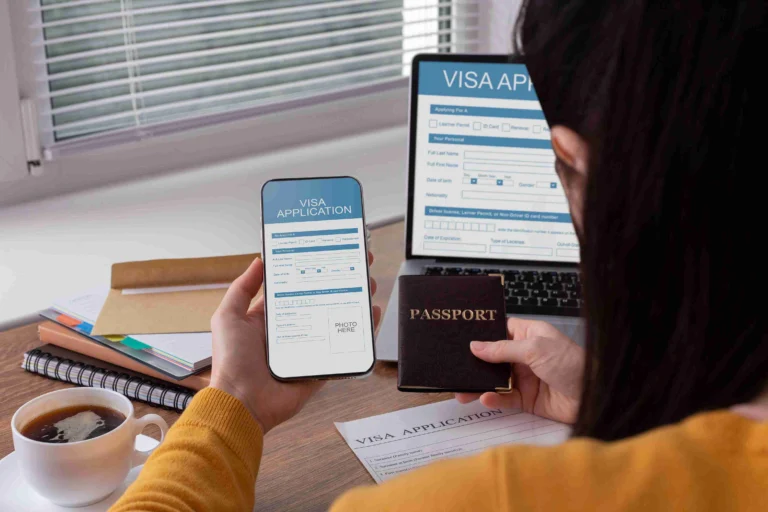
Skilled Worker Visa Australia: 2025 Complete Guide
Securing a Skilled Worker Visa Australia in 2025 offers a direct pathway to permanent residency and a world-class lifestyle. With new rules designed to fast-track applications for in-demand professions, understanding the latest requirements is your key to success. This guide provides the crucial facts on updated occupation lists, eligibility, and benefits to give you a clear advantage in your application.
What is the Skilled Worker Visa Australia?
The skilled worker visa Australia is the main route for professionals who want to live and work in Australia. It’s designed to fill skill gaps in the workforce, and the main program is called General Skilled Migration (GSM). The GSM stream offers three main visa subclasses:
- Subclass 189 (Skilled Independent): Points-tested; no sponsorship from an employer or person is required.
- Subclass 190 (Skilled Nominated): It must be state or territory sponsored.
- Subclass 491 (Skilled Work Regional): This is a provisional visa for living in regional areas, and it is points-tested and state/territory (or relative) sponsored.
These visas bring skilled workers to Australia for jobs that need more people. This helps the country fill gaps in its workforce and helps new workers live and work in Australia easily. There are other visas which use employer sponsorship, such as the Temporary Skill Shortage (visa subclass 482) and the Employer Nomination Scheme (visa subclass 186).
Skilled Worker Visa Australia Benefits
There are many advantages of obtaining a skilled worker visa, which go beyond the fact that it provides an opportunity to work in the country. It offers a firm background on which to establish a life in Australia.
- Pathway to Permanent Residency: A number of skilled visas, including the Subclass 189 and 190, are permanent visas by default, whilst others, including the Subclass 491, offer a straightforward and direct pathway towards permanent residency in a few years.
- Full Work Rights: You and your family members who are with you have the benefit of working and living anywhere in Australia (subject to visa subclass), providing you with a lot of career flexibility.
- Healthcare Access: Visa holders and their families will have access to the high-quality public healthcare system in Australia, Medicare.
- Sponsor Family Members: You may also add your partner and dependent children to your application, and your family can accompany you to Australia. After settling, you can even sponsor other qualified relatives.
- High Standard of Living: The visa opens up Australia and its celebrated quality of living, stable economy and competitive salaries.
- Education and Social Benefits: Your children can study in Australian schools, and after a waiting period, you may become eligible to obtain some social security benefits.
- Pathway to Citizenship: As a permanent visa holder, the first step to becoming an Australian citizen is to obtain a permanent visa, which will grant you the right to vote and hold an Australian passport.
Types of Australia Immigration Skilled Worker Visas
Here’s a brief overview and comparison table for the main skilled migration visas and their requirements:
| Visa Type / Subclass | Eligibility Criteria | Points Test | Nomination | Pathway |
| Subclass 189: Skilled Independent | Proficient English, recognised skills, <45 years | Yes | Not required | Permanent |
| Subclass 190: Skilled Nominated | As above + state nomination | Yes | Required | Permanent |
| Subclass 491: Skilled Work Regional | As above + regional/state/relative nomination | Yes | Required | Provisional (5 years, pathway to PR) |
| Subclass 482: Temporary Skill Shortage | Employer sponsorship, occupation on the list | No | Employer | Temporary (can lead to PR) |
| Subclass 186: Employer Nomination Scheme | Employer sponsorship, occupation on the list | No | Employer | Permanent |
Every visa is accompanied by distinctive conditions, processing schedules, and advantages. To illustrate, Subclass 189 is strictly based on points, while Subclass 491 offers permanent residency to applicants willing to settle in regional areas.
Ready to take the next step in your career? Learn about Australia’s work permit requirements and application process for Indian professionals today.
Australia Skilled Worker Visa List: Eligible Occupations
To successfully apply for a skilled worker visa in Australia, your occupation must be included on an official government list that reflects the country’s economic and labor market needs. These lists are designed to attract professionals to roles where there are skill shortages.
What is the Australia Skilled Worker Visa List?
To apply for a skilled worker visa in Australia, your job needs to appear on an official occupation list:
- Medium and Long-term Strategic Skills List (MLTSSL): For roles with long-term demand.
- Short-term Skilled Occupation List (STSOL): For short-term skill needs; limited PR pathways.
- Regional Occupation List (ROL): For skills in regional Australia.
See the most up-to-date Australia skilled worker visa list at the Department of Home Affairs.
Example:
- Software Engineer (MLTSSL)
- Registered Nurse (MLTSSL)
- Civil Engineer (MLTSSL)
- Café Manager (STSOL)
- Secondary School Teacher (ROL)
In-Demand Occupations for 2025
The Australia skilled worker visa list now includes more roles than ever. Current top in-demand roles:
| Occupation | List | In-Demand Sectors |
| Software Engineer | MLTSSL | Tech / IT |
| Registered Nurse | MLTSSL | Healthcare |
| Accountant | MLTSSL | Finance |
| Civil / Mechanical Engineer | MLTSSL | Engineering |
| Secondary School Teacher | ROL | Education |
| Early Childhood Educator | ROL | Education |
| Marketing Specialist | STSOL | Marketing |
These roles are reviewed annually. See the current occupation lists for a detailed breakdown and eligibility criteria.
Skilled Worker Visa Australia Eligibility & Points System
Meeting Australia’s eligibility criteria is the first step toward a successful skilled visa application. A thorough understanding of the process and careful preparation are essential to improve your chances of approval.
Points-Based System Explained
Applicants must score at least 65 points in the General Skilled Migration pool, but the reality is, you’ll have a much better shot with 75–85 points due to strong competition.
| Factor | Points Range |
| Age | Up to 30 |
| English Proficiency | Up to 20 |
| Skilled Work Experience (overseas) | Up to 15 |
| Skilled Work Experience (Australia) | Up to 20 |
| Educational Qualifications | Up to 20 |
| Australian Study Requirement | 5 |
| State/Territory Nomination | 5–15 |
| Partner’s Skills | Up to 10 |
Most successful applicants have strong English, recent work experience, and higher education.
Use this Australia PR Points Calculator to estimate your score and determine your eligibility for skilled migration visas.
English Language, Health & Character Requirements
You’ll need to pass an approved English test (IELTS, PTE Academic) with minimum scores for your visa. For example:
- IELTS: At least 7.0 in each band (higher scores for bonus points)
- PTE: The PTE Academic test requires a minimum score of 65 in each component.
You’ll also need:
- Police certificates from every country you’ve lived in for 12+ months
- Health checks (medical exam, chest X-ray, etc.)
Resource links for English test prep are available on our homepage.
Skilled Worker Visa Australia Cost & Fees
Below is a detailed breakdown of the various fees associated with applying for a skilled worker visa for Australia.
Skilled Worker Visa Australia Cost Breakdown (2025):
| Item | AUD (2025) | INR (approx)* |
| Visa application (subclass 189/190/491 – main applicant) | 4,910 | ₹268,000-270,050 |
| Additional applicant (over 18) | 2,455 | ₹134,000-₹135,025 |
| Additional applicant (under 18) | 1,230 | ₹67,000-₹67,650 |
| Skills assessment | 300–1,000 | ₹16,400–₹54,800 |
| English language test | 350–400 | ₹19,100–₹21,900 |
| Health checks | 150–300 | ₹8,200–₹16,400 |
| Police certificates | varies | varies |
*1 AUD ≈ 54.5 INR as of July 2025. Always check current rates.
Employer Pathways
- Employer Nomination Scheme (subclass 186): AUD4,910 (~₹268,000), plus employer fees.
Additional Costs & SAF Levy
The Skilling Australians Fund (SAF) levy applies to employer-sponsored visas and varies based on business size:
- For small businesses: AUD1,200 per year per worker
- For large businesses: AUD1,800 per year per worker
- Migration agent or consultant fees (varies by provider)
- Document translation and postage
Downloadable fee calculators and estimates are available.
Step-by-Step Skilled Worker Visa Australia Application Process
The Skilled Worker Visa application process involves several key stages, each crucial to securing your visa and starting your new career in Australia.
Step 1 – Check Eligibility & Select Occupation
- Calculate your score on the points test.
- Select an occupation from the skilled worker visa Australia list.
- Make sure you meet age, English, health, and character requirements.
Checklist format: Downloadable eligibility checklist available.
Step 2 – Skills Assessment
- Apply for an assessment with the relevant authority for your occupation.
- Gather required documents: qualifications, work references, etc.
- Typical timeline: 8–10 weeks.
Step 3 – English Language Test
- Book your test (IELTS, PTE, or TOEFL).
- Prepare using official materials.
- Submit your results online with your application.
Step 4 – Expression of Interest (EOI) via SkillSelect
- Create an online account on SkillSelect.
- Complete your EOI, provide your points score, job, skills, English level, etc.
- Your profile will be ranked for invitations.
Screenshots/infographics are available in our downloadable guides.
Step 5 – Invitation to Apply (ITA) & Visa Application
- If you’re invited, upload all supporting documents (IDs, assessments, English scores, health checks).
- Submit your online visa application and pay the fee.
- Use our step-by-step document checklist for easy tracking.
Step 6 – Health & Character Checks
- Complete a panel medical exam.
- Obtain police clearance certificates for each country lived in for over 12 months.
- Submit scans through your ImmiAccount.
Common questions and troubleshooting are answered in our FAQ.
Step 7 – Visa Grant & Post-Arrival Steps
- You’ll receive your visa grant notification online.
- On arrival, complete:
- Register for Medicare
- Apply for a Tax File Number (TFN)
- Set up a bank account
- Find long-term accommodation
Skilled Worker Visa Australia Processing Time
Understanding the average processing times for Skilled Worker Visas in Australia is crucial for planning your application effectively and managing expectations in 2025.
Average Processing Times (2025):
| Visa / Stream | 75% Processed In | 90% Processed In |
| Subclass 189 | 8–9 months | 13–14 months |
| Subclass 190 | 9 months | 14–16 months |
| Subclass 491 | 7–9 months | 18–24 months |
| Employer-sponsored | 10–12 months | 14 months |
Tips for faster processing:
- Submit all documents at once.
- Respond quickly to requests.
- Choose occupations in high demand.
Common Challenges & Solutions
Understanding common challenges can help you overcome obstacles in your skilled visa application journey.
Points Shortfall & Competition
If you don’t meet the minimum points:
- Retake English language tests for higher scores.
- Gain more skilled work experience.
- Consider state nomination for the subclass 190 or 491 to get extra points.
- Use the points calculator for strategy.
Document & Assessment Issues
Q: What do I do in case the documentation that I possess is not in English?
A: All the documents will require a certified translator.
Q: What can I do if I do not want to provide an evaluation of my skills?
A: You will, in such a case, be asked normally to provide the missing information, and this can cause a hold in processing your application.
Q: How can I avoid making mistakes?
A: Apply the free tool to our assessment and professional document checklist. Experts at Visa Axis can help call 91 72049 55253 for advice.
Recent Policy Updates for Australia Immigration Skilled Worker Visa
Staying informed about the latest policy changes is crucial for a successful application.
2025 Policy Changes
- Visa application charges increased by 3% from July 2025.
- Minimum income thresholds rose to AUD76,515 (Core) and AUD141,210 (Specialist).
- Occupation lists revised—new in-demand roles now included on the official list.
- Processing priorities updated: critical skills and regional areas are given faster review.
Expert Insight
Australia’s migration policy is now laser-focused on real labour market needs. Applicants in STEM, health, and key engineering fields will find greater opportunity. Take advantage of new incentives for regional settlement and keep an eye out for future occupation list updates.
Start your journey to Australian PR. Enrol in a skilled course today!
Conclusion
The skilled worker visa Australia process in 2025 is clear and accessible for those who match the country’s workforce needs. With updated occupation lists, a straightforward points system, and transparent costs, your path to living and working in Australia starts with the right application and expert guidance. If you’re considering this exciting move, now is the perfect time to explore your eligibility and get help from our experts. Call 91 72049 55253 or connect with Visa Axis for a free consultation—your Australian journey could be just a click away!
Frequently Asked Questions (FAQs)
Q1. How many points does one need on a skilled worker visa in Australia?
Ans. You must have 65 points to be eligible. The majority of successful applicants, however, get 75-85 points to increase their chances of getting an invitation.
Q2. What will be the cost of seeing the skilled worker visa Australia in 2025?
Ans.AUD4,910 to the primary applicant (subclass 189, 190, 491) and additional fees to other applicants, skills assessment charge, English test, medical checks, and additional.
Q3. What is the list of Australia’s skilled workers?
Ans. It is the list of skilled migration occupation schedules approved by the government (MLTSSL, STSOL and ROL) of needed occupations. To apply, your job has to be listed.
Q4. What is the processing time for getting a skilled worker visa in Australia?
Ans. The processing time of a skilled worker visa in Australia, including the subclass 189 or 190, may be different. In the case of the Skilled Independent visa (subclass 189), 90 per cent of applications take less than 12 months and in some cases, under 4-6 months. The Skilled nominated visa (subclass 190) has a comparable duration, and most of the applications are processed within 8 to 12 months.
Q5. Can I bring my family members when applying for a skilled worker visa?
Ans. Yes, dependent children and a spouse are allowed, but this case raises the amount of money you have to spend and the number of documents to be provided in your application.



